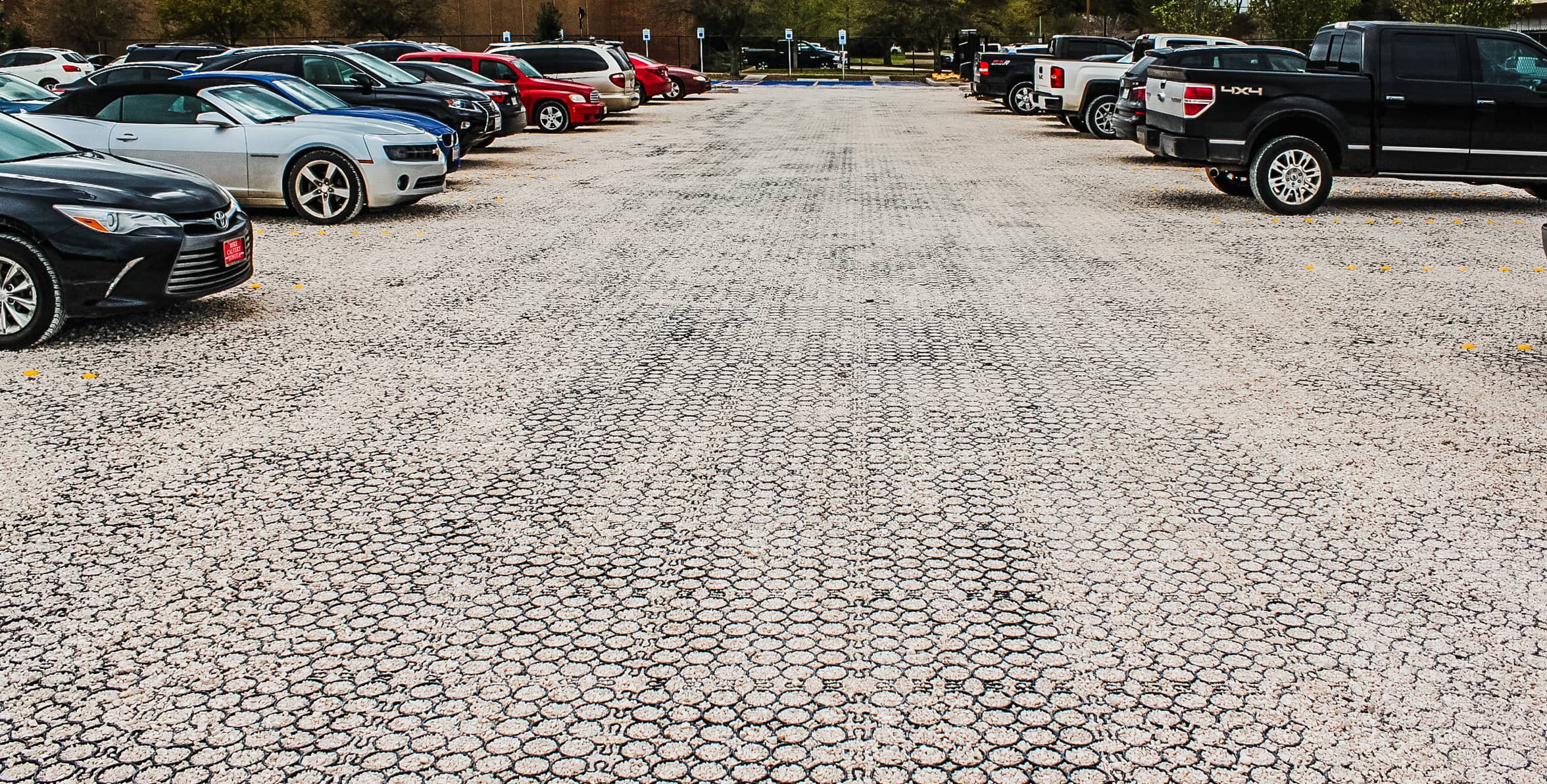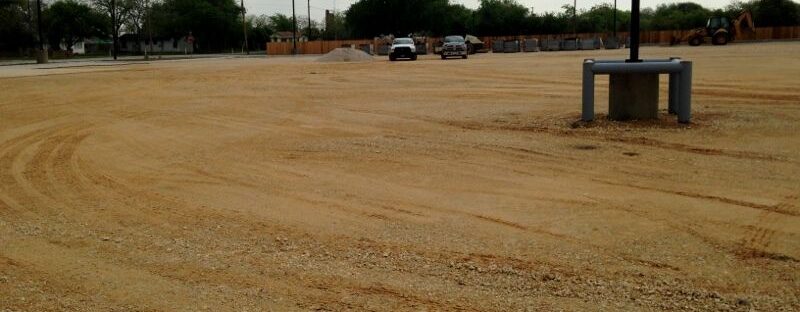
Parking lots often go unnoticed in urban landscapes, yet they quietly contribute to urban flooding, water pollution, and heat islands. With millions of square feet covered by asphalt and concrete, these spaces have become hidden drivers of environmental challenges—but it doesn’t have to be that way.
The rise of green parking lots offers a smarter approach—spaces that manage stormwater, reduce heat, and even support biodiversity—all without sacrificing durability or aesthetics. And the key? It often comes down to what’s beneath your tires.
Why Parking Lots Play a Role in Sustainability
Urban areas are covered with impervious surfaces that block rainwater from soaking into the ground, leading to stormwater runoff, flooding, and heat islands. But parking lots don’t have to contribute to these problems. Eco-friendly parking lots use permeable materials and smart design to manage water, reduce heat, and minimize environmental impact—without sacrificing durability.
The Impact of Impervious Surfaces on Cities
Traditional parking lots, made of asphalt and concrete, block rainwater from seeping into the ground, causing excess runoff and flooding. These hard surfaces also trap heat, contributing to the urban heat island effect—a challenge that can be mitigated through thoughtful design strategies like tree canopies, permeable materials, and sustainable parking lot materials that promote natural drainage.
A Smarter Approach to Parking Lot Design
But eco-friendly parking lots flip the script. Instead of treating water as a problem to whisk away, they manage it at the source. Sustainable parking lot design focuses on using permeable materials and smart strategies to allow water to infiltrate, filter, and recharge local ecosystems.
Knowing how to make parking lots more sustainable starts with thoughtful design—integrating materials that manage water, reduce heat, and support biodiversity. It’s not just about water, though. Green parking lots help combat the urban heat island effect, reduce maintenance costs, and often qualify for green building credits—making them as practical as they are eco-conscious.
The Materials That Make It Work

A truly eco-friendly parking lot starts with smart material choices. Sustainable parking lot design relies on materials like:
- porous asphalt,
- pervious concrete,
- Permeable gravel and grass grids,and
- recycled aggregates
to manage stormwater and reduce environmental impact. But for maximum water absorption and durability, permeable grid pavers stand out.
Designed for both strength and sustainability, they turn parking lots into effective tools for stormwater management—while also reducing surface heat and long-term maintenance needs.
Designing Multi-Functional Parking Lots
A truly eco-friendly parking lot is more than just a place to leave your car; it’s a mini ecosystem designed to manage water, reduce heat, and support local wildlife. Using sustainable parking lot materials ensures these ecosystems function efficiently while minimizing their environmental footprint.
Bioswales and Rain Gardens
These capture runoff and help it slowly infiltrate the ground while filtering out pollutants. They also reduce the burden on municipal drainage systems, helping to minimize flooding during heavy storms. Plus, by incorporating native plants, they create habitats for local wildlife and enhance the visual appeal of parking lots.
Tree Canopies
Tree canopies do more than offer shade—they’re a frontline defense against the urban heat island effect, where heat-absorbing surfaces like asphalt raise local temperatures. In dense urban areas, this phenomenon not only increases cooling costs but also intensifies air pollution and reduces comfort for pedestrians.
By planting shade-providing trees throughout parking lots, designers can lower surface temperatures, reduce heat absorption, and create more comfortable, energy-efficient spaces. In combination with permeable paving and strategic landscaping, tree canopies play a critical role in creating cooler, greener urban environments.
Strategic Grading
Strategic grading directs water toward permeable areas like bioswales, rain gardens, and permeable pavers, reducing flooding and promoting groundwater recharge. This simple design reduces strain on storm drains, prevents erosion, and supports healthier ecosystems—all while minimizing long-term maintenance.
How Permeable Pavers Change the Game

While tree canopies reduce heat from above, permeable pavers tackle it from below.
- Unlike asphalt, which absorbs and retains heat, TRUEGRID’s permeable pavers allow airflow and water filtration beneath the surface, naturally cooling the area.
- Combined with reflective materials and light-colored gravel, these systems help lower overall surface temperatures, making parking lots cooler and more efficient. This parking lot in Central Texas is a great example.
Sustainability isn’t just about going green—it’s also about protecting your bottom line.
Shifting Mindsets: Sustainability That Saves
Many developers hesitate to adopt green infrastructure, assuming higher costs. But permeable pavers often lead to significant long-term savings.
By reducing the need for:
- complex drainage systems,
- cutting maintenance costs, and
- qualifying for municipal incentives,
Sustainable parking lot materials help property owners see a quicker return on investment while aligning with green building standards.
Plus, many cities offer tax credits and grants for projects that integrate stormwater management and sustainable materials—making the switch to eco-conscious parking solutions a financially smart move. Oftentimes, cities will already have an impermeable surface limit making a permeable system a cost-effective solution for development.
Think Beyond the Lot
Sustainable parking lots don’t exist in a vacuum—they’re part of a broader shift toward low-impact development. When integrated with green roofs, urban gardens, and other eco-conscious strategies, they help create healthier, more resilient cities.
Whether you’re building a small commercial lot or a large-scale urban complex, design choices matter. Opting for materials like permeable pavers and incorporating thoughtful landscaping isn’t just about compliance—it’s about legacy.
Ready to Build Greener? TRUEGRID Has You Covered
Sustainability starts at the ground level—literally. TRUEGRID’s permeable pavers make it easy to create parking lots that are functional, attractive, and eco-friendly. Whether you’re tackling stormwater issues or aiming for LEED certification, we have solutions designed to meet your needs. Contact us today for more information.



